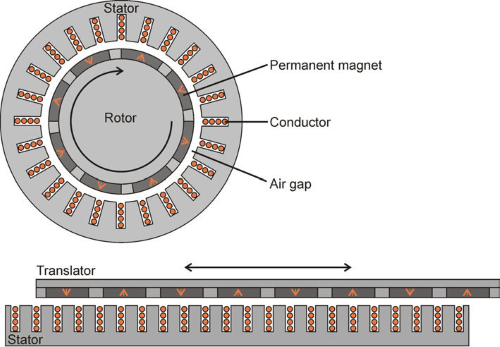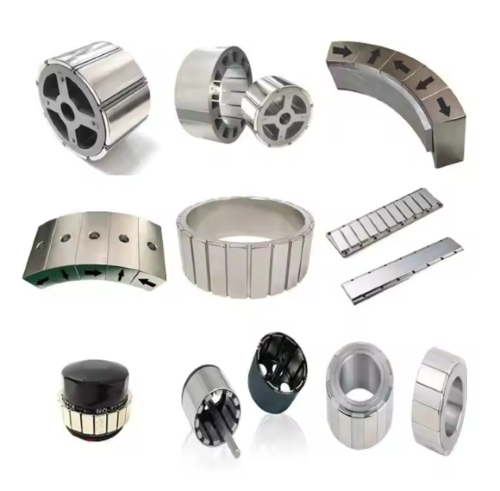Permanent Magnet Generator: An Overview
Introduction
Permanent magnet generators (PMGs) are innovative devices that convert mechanical energy into electrical energy using permanent magnets to create a magnetic field. These generators are notable for their high efficiency, reliability, and reduced maintenance requirements compared to traditional generators. This article will discuss their components, working principles, types, and applications.
 [1]
[1]
Components of Permanent Magnet Generators
Permanent Magnet Generators (PMGs) are essential in various applications. To understand their functions, it's important to explore the key components of these generators.
- Rotor:
The rotor is the rotating component of the generator. It is embedded with permanent magnets. These magnets provide a consistent and strong magnetic field as the rotor spins.
- Stator:
The stator is the stationary part that houses the rotor. It contains windings (coils of wire) where the induced voltage is generated.
Permanent magnets like neodymium, samarium-cobalt, or ferrite, create a stable magnetic field without the need for an external power source. They enhance the generator's efficiency.
- Bearings:
Bearings support the rotor, so the rotor can spin smoothly within the stator. High-quality bearings reduce friction and wear and contribute to the generator's longevity.
- Cooling System:
PMGs may include a cooling system to dissipate heat generated during operation. The cooling system ensures optimal performance and prevents overheating.
 [2]
[2]
Working Principles of Permanent Magnet Generators
PMGs play a pivotal role in converting mechanical energy into electrical energy. Here is how these generators function.
- Initially, mechanical energy is applied to the shaft, causing it to rotate. As the rotor spins, it creates a changing magnetic field. This dynamic magnetic field then interacts with the stator, which contains copper windings. The interaction between the rotating magnetic field and the stationary windings induces an electric current in the stator.
- Thereafter, the bearings ensure that the rotor spins smoothly by reducing friction and supporting the shaft. The entire process is housed within a sturdy frame, protecting the internal components and maintaining structural integrity.
- Finally, control systems regulate the generator's output, so the electrical energy produced is stable and consistent. These systems optimize performance and enhance the generator's efficiency.
- With these working principles, Permanent Magnet Generators efficiently convert mechanical energy into reliable electrical power, supporting a wide range of applications.
Types of Permanent Magnet Generators
These efficient generators come in various types. Each of them is suitable for different applications and operational requirements.
- Brushless PMGs are highly favored due to their low maintenance requirements and longer lifespan. These generators eliminate the need for brushes and slip rings, reducing wear and tear and enhancing overall efficiency.
- Axial Flux PMGs come with a compact and lightweight design. These generators are ideal for applications such as in the automotive and aerospace industries.
- Radial Flux PMGs are the most common design used in wind turbines and industrial applications. These generators stand out for their robust construction and high power output, making them suitable for heavy-duty operations.
- High-Speed PMGs are designed to operate at very high rotational speeds, providing a higher power density. These are typically used in applications requiring a compact generator with a high power-to-weight ratio, such as in micro-turbines and small-scale power systems.
- Low-Speed PMGs are specifically suitable for applications like hydroelectric power generation, where the rotational speeds are relatively low. These generators are built to provide consistent power output even at low speeds, ensuring reliability and efficiency in their specific use cases.

Related reading: What are the Benefits of Permanent Magnet Generators?
Applications of Permanent Magnet Generators
-
- Wind Turbines:
PMGs find wide use in wind turbines due to their high efficiency and reliability. They convert the mechanical energy of the rotating blades into electrical energy, harnessing wind power for renewable energy generation.
Related reading: Application of Permanent Magnets in Wind Turbines
-
- Hydropower:
In small-scale hydropower systems, PMGs convert the mechanical energy of flowing water into electrical energy. Their efficiency and low maintenance make them ideal for remote or off-grid locations.
-
- Electric Vehicles:
PMGs are employed in electric vehicles to generate electricity from regenerative braking systems, improving overall energy efficiency and extending battery life.
-
- Portable Generators:
Compact and efficient PMGs are useful in portable generators, providing a reliable power source for outdoor activities, construction sites, and emergency backup power.
-
- Marine Applications:
PMGs are utilized in marine environments to generate electricity from wave or tidal energy. Their durability and resistance to harsh conditions make them suitable for maritime use.
Efficiency and Maintenance
Permanent magnet generators are highly efficient due to the consistent and strong magnetic field provided by permanent magnets. They require minimal maintenance compared to traditional generators, as they lack brushes and slip rings that wear out over time. Regular inspections of bearings and cooling systems, along with periodic cleaning, ensure optimal performance and longevity.
Conclusion
Permanent magnet generators are a significant advancement in generator technology thanks to their high efficiency, reliability, and low maintenance. Understanding their components, principles, types, and applications is crucial for leveraging their benefits in various fields.
From renewable energy systems like wind and hydropower to electric vehicles and portable generators, PMGs play a vital role in modern energy generation. They are going to lead to a sustainable and efficient future.
Stanford Magnets is a reliable supplier of diverse magnet assemblies. Permanent magnet generators, magnet rotors, and halbach arrays are available. Customization is also available. Send us an inquiry if you are interested.
Reference:
[1] Waters, Rafael. Energy from Ocean Waves Full Scale Experimental Verification of a Wave Energy Converter.
[2] Hong, J.-S.; Lee, H.-K.; Nah, J.; Kim, K.-H.; Shin, K.-H.; Choi, J.-Y. Semi-3D Analysis of a Permanent Magnet Synchronous Generator Considering Bolting and Overhang Structure. Energies 2022, 15, 4374. https://doi.org/10.3390/en15124374














